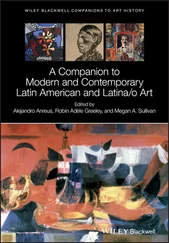A Companion to Arthur C. Danto
Здесь есть возможность читать онлайн «A Companion to Arthur C. Danto» — ознакомительный отрывок электронной книги совершенно бесплатно, а после прочтения отрывка купить полную версию. В некоторых случаях можно слушать аудио, скачать через торрент в формате fb2 и присутствует краткое содержание. Жанр: unrecognised, на английском языке. Описание произведения, (предисловие) а так же отзывы посетителей доступны на портале библиотеки ЛибКат.
- Название:A Companion to Arthur C. Danto
- Автор:
- Жанр:
- Год:неизвестен
- ISBN:нет данных
- Рейтинг книги:5 / 5. Голосов: 1
-
Избранное:Добавить в избранное
- Отзывы:
-
Ваша оценка:
- 100
- 1
- 2
- 3
- 4
- 5
A Companion to Arthur C. Danto: краткое содержание, описание и аннотация
Предлагаем к чтению аннотацию, описание, краткое содержание или предисловие (зависит от того, что написал сам автор книги «A Companion to Arthur C. Danto»). Если вы не нашли необходимую информацию о книге — напишите в комментариях, мы постараемся отыскать её.
Companion
A Companion to Arthur C. Danto
A Companion to Arthur C. Danto — читать онлайн ознакомительный отрывок
Ниже представлен текст книги, разбитый по страницам. Система сохранения места последней прочитанной страницы, позволяет с удобством читать онлайн бесплатно книгу «A Companion to Arthur C. Danto», без необходимости каждый раз заново искать на чём Вы остановились. Поставьте закладку, и сможете в любой момент перейти на страницу, на которой закончили чтение.
Интервал:
Закладка:
Sartre’s notion of consciousness as a nothingness is the topic of the longest chapter in Jean-Paul Sartre , but it also figures prominently in Danto’s discussion of artistic style in The Transfiguration of the Commonplace . What makes something an artwork? Danto insists that it cannot be a peculiar kind of aesthetic property visible in the object, just as real (i.e., ordinary) qualities are visible in real (i.e., ordinary) objects. Nor can the artistic character of a work of art lie in its semantic content , that is, in what it says or means, on analogy with the meaning of a sentence. Semantic theories of art are especially implausible when we try to transfer the putative transparency of consciousness to the way in which artworks manage to have the kind of meaning they have. What Danto calls the “transparency theory” of art – a mimetic theory that figured prominently in Renaissance discourse surrounding unified linear perspective and techniques for capturing the reflection of light in metal, glass, and the human eye – is the idea that artworks aspire to the inconspicuousness of a pure medium, like a lens or a window through which we see the world. On this theory, Danto says, “the artwork is the message and the medium is nothingness, much in the way in which consciousness is held, by Sartre for instance, to be a kind of nothingness. It is not part of the world but that through which the world is given, not being given itself” (1981, 152). Like consciousness in its prereflective transcendence toward the world, such a medium of artistic representation would achieve “pure diaphaneity” (1981, 157), having no properties of its own beyond those of the objects exhibited through it.
Danto rejects the transparency theory as inadequate to how we talk about art and to artistic practice. Even the finest achievements of geometrical perspective and optical realism, after all, are nothing like actual illusion or trompe-l’œil (1981, 158). Nor do artworks simply mirror or reproduce the qualities of the things they represent. A painter might depict a blue sky with blue paint, but she might use yellow or green. Moreover, there is an obvious distinction between beautiful images of things and images of beautiful things: consider Matthias Grünewald’s Isenheim Altarpiece, Caravaggio’s paintings of biblical beheadings, and William Eggleston’s radiant color photographs of parking lots, lawn furniture, and abandoned gas stations.
For Danto, an artwork is not a mere representation, with a particular kind of content (1981, 168). An artwork is constituted not by its aesthetic qualities or its semantic contents, but by something like rhetorical tropes, particularly metaphor . Metaphors are philosophically interesting not just because they exceed literal language, but because they stand outside the realm of ordinary meaning altogether. It is not that they say something esoteric, but that what they say is so manifestly inadequate to, even in a kind of tension with, what they allow us to see, feel, and understand. Content , then, at least as philosophers and linguists use that term, is the wrong place to look for the essence of art. Echoing a familiar theme from traditional aesthetic theory, Danto reminds us that “it is crucial to distinguish the form of a representation from the content of the representation” (1981, 172). A statue of Napoleon wearing a toga, sandals, and a laurel wreath could be the depiction of an actual (though unlikely) episode in real life, one that might have been a rhetorical gesture on Napoleon’s part. But that statue would not be the same as Eugène Guillaume’s 1859 sculpture Napoleon Ier, législateur , which is not a depiction of a rhetorical gesture but is itself a rhetorical gesture. Indeed, the two statues would not be the same even if they were qualitatively indistinguishable. As its title hints, Guillaume’s sculpture is not the image of something metaphorical, but a metaphorical image. Metaphors, whether verbal or pictorial, do not merely say or mean something peculiar in content; they “transfigure” what they present or refer to, even when they do so by means of content they share with nonmetaphorical expressions. Though it might be the same proposition, “Juliet is the sun” said by Romeo is not “Juliet is the sun” said by someone who has mistaken her for a giant ball of gas. For Danto, “every metaphor is a little poem,” indeed “metaphors are minor works of art” (1981, 189).
That is somewhat hyperbolic. Not all rhetoric is art. In addition to transfiguring their subjects, artworks draw attention to the way they do so; they exhibit the style in which they represent what they represent. What is style? Danto begins by drawing an analogy, in Sartrean terms, between historical periods and individual persons:
Each has a kind of interior and an exterior, a pour soi and a pour autrui . The interior is simply the way the world is given. The exterior is simply the way the former becomes an object to a later or another consciousness. While we see the world as we do, we do not see it as a way of seeing the world: we simply see the world. Our consciousness of the world is not part of what we are conscious of (1981, 163).
A style, historical or personal, is a kind of “global coloration,” something like what Frege calls the subjective Färbung in contrast to the objective content of a proposition. Consciousness colors reality, but in a way ordinarily invisible to consciousness itself, just as the tint of sunglasses vanishes as one acclimates to them on a sunny day.
What is transparent to me, however, is opaque to others. What do they see, that I do not, in the idiosyncrasies of my appearance and behavior? “The term style derives etymologically from the Latin term stilus – a pointed instrument for writing,” Danto tells us, and adds.
It is as if, in addition to representing whatever it does represent, the instrument of representation imparts and impresses something of its own character in the act of representing it, so that in addition to knowing what it is of, the practiced eye will know how it was done.
We may thus reserve the term style for this how , as what remains of a representation when we subtract its content – an algorithm licensed by the contrast between style and substance enshrined in usage (1981, 197).
In this same spirit, Danto cites Buffon’s observation that style is the man: “it is the way he represents the world, minus the world,” so that the style-inflected “qualities of the representation do not penetrate the content” (1981, 198). Style is also characterized by “the absence of a mediating knowledge or art,” and here Danto appeals again to the transparency of consciousness – beliefs, for example, being “transparent to the believer; he reads the world through them without reading them. … Thus the structure of my beliefs is something like the structure of consciousness itself, as viewed by the great phenomenologists,” notably Sartre (1981, 206). Style, then, is “those qualities of representations which are the man himself, seen from the outside, physiognomically,” qualities that “are not commonly given to the man whose representations they are: he views the world through them, but not them.” Moreover, “to be his style they have to expressed immediately and spontaneously” (1981, 207).
Here I think we need to distinguish artistic style from mere innate or spontaneous character . Kierkegaard reminds us that, like style according to Danto, “character is something engraved,” the Greek χαρακτήρ meaning stamp, mark, or distinctive feature (Kierkegaard 2001 [1846], 69). It is visible primarily if not exclusively, Sartre says, from a third-person perspective, whereas my primary relation to myself is the transparent egolessness in which, strictly speaking, I do not appear to myself at all. Prereflectively, I am (literally) nothing but my transcendence toward the world; it is only in my encounter with others that I am (so to speak) robbed of my self by their gaze, which captures me in my visible aspect, in my facticity . What is crucial in this is precisely the fact that what the other sees is no mere image or shadow of my true self, but me . Or, to indulge the analogy for a moment, if my self is like an image or shadow present to others, Sartre says, it is the “hidden side of the cards” they hold, “a shadow that is projected on to some moving and unpredictable material, such that no system of cross-references could allow us to calculate the distortions resulting from these movements” (2018 [1943], 359). The analogy with images and shadows is necessarily misleading, however, for the force and significance of the other’s gaze is precisely that it penetrates me , touches me to the core: I am vulnerable to it because there is no separation between what the other sees and the self I know myself to be. As Sartre insists, “it really is a question of my being, and not my being’s image” (2018 [1943], 359).
Читать дальшеИнтервал:
Закладка:
Похожие книги на «A Companion to Arthur C. Danto»
Представляем Вашему вниманию похожие книги на «A Companion to Arthur C. Danto» списком для выбора. Мы отобрали схожую по названию и смыслу литературу в надежде предоставить читателям больше вариантов отыскать новые, интересные, ещё непрочитанные произведения.
Обсуждение, отзывы о книге «A Companion to Arthur C. Danto» и просто собственные мнения читателей. Оставьте ваши комментарии, напишите, что Вы думаете о произведении, его смысле или главных героях. Укажите что конкретно понравилось, а что нет, и почему Вы так считаете.












